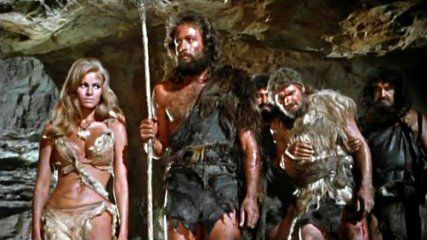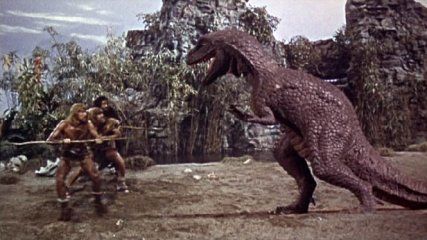This is a story of long, long ago, when the world was just beginning.


Leaving aside 1956's The Animal World, which I've decided to can safely skip, the last film featuring Ray Harryhausen's stop-motion animation that I needed to see was Hammer's One Million Years B.C., which TCM was kind enough to air a couple months back. Made in 1966 and directed by Don Chaffey (late of Harryhausen's Jason and the Argonauts) from a screenplay by producer Michael Carreras, this remake of 1940's One Million B.C. was designed from the ground up to be a vehicle for Raquel Welch, who stars as Loana, a buxom blonde belonging to the beach-dwelling Shell Tribe. We don't meet her until nearly a half hour in, though, as we encounter them at the same time as Rock Tribesman Tumak (John Richardson, pleasingly hairy-chested), who's wandered away from his people after unsuccessfully challenging their leader, Akhoba (Robert Brown, the hairiest of them all), who also happens to be his father.
Compared to the Rock Tribe, which is extremely primitive and aggressive (not nearly nearly as much as the super-hirsute hominids that dwell in the cave Tumak has to duck into to escape the first dinosaur he encounters during his exile), the Shell Tribe is a haven of progress. Not only do they have cave paintings, indoor plumbing, agriculture, throwing weapons, and respectful burial practices (unlike the Rock Tribe, which leaves their old and infirm to the buzzards), they've also developed a sense of humor and have invented the concept of bathing. While Tumak learns all about these wonders, his brother Sakana (Percy Herbert) is consolidating his power as the new tribal leader after usurping Akhoba's position, thus priming the pump for a calamitous sibling rivalry manifested as an inter-tribal clash between the blondes and the brunettes.
Welch aside, One Million Years B.C.'s main points of interest today are the special visual effects created by Harryhausen, although it can't help but be a disappointment when the first "dinosaur" that shows up is just a lizard matted into the shots of Richardson (and vice versa), however well it's done. All the usual prehistoric suspects are present and accounted for, though, and animated to the best of the technical wizard's ability. Harryhausen was also in charge of the apocalyptic finale, when the volcano that that Rock Tribe lives in the shadow of blows its top, as it's been threatening to do for the entire movie. That's one way to put the petty squabbling of two tribes into perspective.